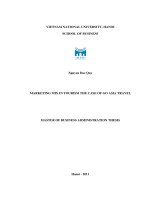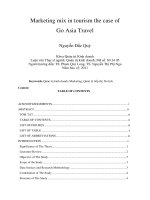Marketing chapter 6a prospecting the lifeblood of selling
Bạn đang xem bản rút gọn của tài liệu. Xem và tải ngay bản đầy đủ của tài liệu tại đây (591.29 KB, 39 trang )
6
Chapter
Prospecting—The Lifeblood
of Selling
McGraw-Hill/Irwin
ABC’s of Selling, 10/e
Copyright © 2009 by The McGraw-Hill Companies, Inc. All rights reserved.
Main Topics
The Tree of Business Life: Prospecting
The Sales Process Has 10 Steps
Steps Before the Sales Presentation
Prospecting—The Lifeblood of Selling
The Leaking Bucket Customer Concept
Where to Find Prospects
Planning a Prospecting Strategy
Prospecting Methods
Prospecting Guidelines
6-2
Main Topics, cont...
The Referral Cycle
Call Reluctance Costs You Money!
Obtaining the Sales Interview
Wireless E-mail Helps You Keep in Contact and Prospect
6-3
The Tree of Business Life: Prospecting
Guided by The Golden Rule, remember:
T
T
T
T
T T
T
T
Builds
ce
Et
hi
ca
T
rvi
Se
l
T
T
People buy from those they know and trust
Prospecting is not easy unless you focus on helping,
not selling
People who trust you give referrals
Referrals take the burden of prospecting off the
salesperson
True
Referrals are earned through integrity, trust, and
character
Relationships
T
I
C
6-4
Exhibit 6-1: The Selling Process Has
10 Important Steps
1. Prospecting
The sales process is a sequential
series of actions
2. Preapproach
3. Approach
4. Presentation
5. Trial close
6. Determine objections
7. Meet objections
8. Trial close
9. Close
10. Follow up
6-5
Some Prospect, Some Do Not
Many salespeople prospect, both those selling business-to-business and those selling
to consumers
Examples are:
Financial services as life insurance
Real estate
6-6
Some Prospect, Some Do Not, cont…
Many organizations do not prospect
Examples are large consumer goods firms, such as General Mills* and Colgate*
* products and associated images used for illustrative purposes only
6-7
Compensation for the Salesperson that Prospects is Sometimes:
Based upon 100% commission – if you do not sell, you do not earn
6-8
Compensation for the Salesperson that Does Not Prospect is
Often:
Based upon mostly salary with a small bonus and expenses such as car and office
supplies paid
If you do not sell you still get paid, but not for very long
6-9
The Prospector Has the Most Challenging Sales Career
This is the “order getter” who:
Finds a lead
Converts the lead into a prospect
Sells one day, and
Sells in the future too
WOW! That is a challenge
6-10
Steps Before the Sales Presentation
Prospecting > Appointment > Planning
Rule of thumb
40% preparation
20% presentation
40% follow-up
6-11
Exhibit 6-2: Before the Sales Presentation
6-12
Prospecting–The Lifeblood of Selling
Prospecting – identifies potential customer
Lead – name of a person or organization (also referred to as a
suspect)
Prospect – qualified person or organization
6-13
Prospecting — The Lifeblood of Selling
Prospecting – identifies potential customers
Lead – might be a prospect
Prospect – qualified person
Is prospect MAD? Does he or she have:
Q1. Money to buy?
Q2. Authority to buy?
Q3. Desire to buy?
…Then, prospect is Qualified
Prospecting–The Lifeblood of Selling
Sales Prospecting Funnel
All leads and prospects must be considered and filtered through the MAD process before they
become qualified prospects
6-15
The Leaking Bucket Customer Concept
All salespeople lose X amount of sales and customers per year. This is illustrated in
the Leaking Bucket Customer Concept:
Customers come into the top and leave through a hole in the bottom
6-16
Where to Find Prospects
Sources may be varied or few
Persons selling different services and goods might not use the same sources
6-17
Planning a Prospecting Strategy
Prospecting requires a strategy
A skill that can be constantly improved
6-18
Exhibit 6-4: Prospecting Methods that Work!
6-19
Prospecting Methods
E-prospecting on the Web
Individuals
Organizations
(1)Cold Canvassing – law of averages
(2)Endless Chain – customer referral
Customers and customer referrals best sources of future sales
(3)Orphaned Customers
(4)Sales Lead Clubs
6-20
Prospecting Methods, cont…
Prospect Lists – trade pubs, list-selling firms
Become an Expert – get published
(5)Public Exhibitions and Demonstrations
(6)Center of Influence
Direct Mail
(7)Telephone and Telemarketing
Observation
(8)Networking (center-of-influence people)
6-21
Exhibit 6-5: The Processing System Within a Telemarketing
Center
6-22
Exhibit 6-6: Reports From a Telemarketing Center to Other Marketing Groups Within
the Firm
6-23
Prospecting Guidelines
Three criteria are:
1.Customize to each prospect
2.Concentrate on high potential customers fruit
3.Call back on no-buys
Always keep knocking on prospect’s and customer’s door to help them
6-24
Referrals Are Used in Most Prospecting Methods
Eight of the twelve popular prospecting methods directly ask for
referrals.
Referrals can be directly used in:
Cold canvassing
Endless chain customer referrals
Orphaned customers
Sales lead clubs
Public exhibitions and demonstrations
Center of influence
Telephone
Networking
6-25









